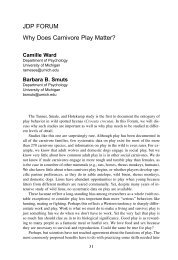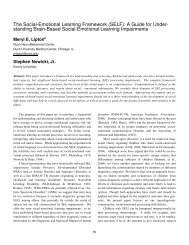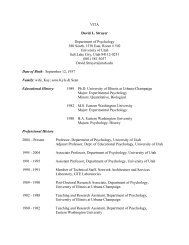Friendship and Friendship Quality in Middle Childhood ... - Psychology
Friendship and Friendship Quality in Middle Childhood ... - Psychology
Friendship and Friendship Quality in Middle Childhood ... - Psychology
Create successful ePaper yourself
Turn your PDF publications into a flip-book with our unique Google optimized e-Paper software.
erately to highly <strong>in</strong>tercorrelated, with rs rang<strong>in</strong>g from. 16 to .75<br />
<strong>in</strong> absolute magnitude. 6 Conflict <strong>and</strong> Betrayal correlated negatively<br />
with all other subscales. All other subscales were positively<br />
<strong>in</strong>tercorrelated.<br />
Acceptance <strong>and</strong> friendship quality. The focus of this analysis<br />
was on whether low-accepted children who have mutual very<br />
best friendships have friendships that are of comparable quality<br />
to the friendships of other children. This issue was exam<strong>in</strong>ed <strong>in</strong><br />
a 2 (gender) X 3 (level of acceptance) multivariate analysis of<br />
variance, with the six subscale scores from the FQQ serv<strong>in</strong>g as<br />
dependent variables. 7<br />
The results of this analysis yielded a significant multivariate<br />
ma<strong>in</strong> effect for gender, F(6, 454) = 4.87, p < .001; a significant<br />
multivariate ma<strong>in</strong> effect for level of acceptance, F(l 2, 910) =<br />
3.17, p < .001; <strong>and</strong> a nonsignificant multivariate Gender X<br />
Level of Acceptance <strong>in</strong>teraction, F(\2, 910) = 1.32. Follow-up<br />
univariate analyses revealed gender differences for four of the<br />
six friendship quality variables. Table 2 gives the mean, st<strong>and</strong>ard<br />
deviation, <strong>and</strong> sample size for each gender on each of the<br />
six friendship quality variables <strong>and</strong> the correspond<strong>in</strong>g F value<br />
for the gender comparison. Boys <strong>and</strong> girls did not differ <strong>in</strong> their<br />
characterizations of their very best friendship with respect to<br />
either conflict <strong>and</strong> betrayal or companionship <strong>and</strong> recreation.<br />
However, boys did report less <strong>in</strong>timate exchange, more difficulty<br />
resolv<strong>in</strong>g conflict, less validation <strong>and</strong> car<strong>in</strong>g, <strong>and</strong> less<br />
help <strong>and</strong> guidance <strong>in</strong> their friendships than did girls.<br />
Follow-up univariate analyses <strong>in</strong>dicated acceptance-level differences<br />
for five of the six friendship quality variables. Table 3<br />
shows these results. The mean, st<strong>and</strong>ard deviation, <strong>and</strong> sample<br />
size for each acceptance group for each friendship quality variable<br />
are also shown <strong>in</strong> Table 3, along with the ^statistic for each<br />
correspond<strong>in</strong>g comparison <strong>and</strong> the results of post hoc pairwise<br />
comparisons of means (Tukey).<br />
As shown <strong>in</strong> Table 3, children of differ<strong>in</strong>g levels of acceptance<br />
did not differ significantly with respect to how much<br />
companionship <strong>and</strong> recreation they saw their friendships as<br />
provid<strong>in</strong>g. However, by their reports, low-accepted children's<br />
friendships were less adequate than the friendships of other<br />
children <strong>in</strong> every other respect. Low-accepted children reported<br />
significantly less validation <strong>and</strong> car<strong>in</strong>g, more difficulty<br />
resolv<strong>in</strong>g conflict, <strong>and</strong> less help <strong>and</strong> guidance than both highaccepted<br />
<strong>and</strong> average-accepted children, who did not differ<br />
from one another <strong>in</strong> these respects. Low-accepted children also<br />
reported significantly less <strong>in</strong>timate disclosure <strong>in</strong> their friendships<br />
than high-accepted children. Low-accepted children reported<br />
more conflict <strong>and</strong> betrayal <strong>in</strong> their friendships than did<br />
average-accepted children but not more conflict <strong>and</strong> betrayal<br />
than high-accepted children, although the means were <strong>in</strong> that<br />
direction. High-accepted children reported somewhat more<br />
conflict <strong>and</strong> betrayal than average-accepted children, but this<br />
difference was not significant. F<strong>in</strong>ally, it is of <strong>in</strong>terest that lowaccepted<br />
children showed the greatest variability of any group<br />
on every friendship quality, except conflict <strong>and</strong> betrayal (see the<br />
st<strong>and</strong>ard deviations <strong>in</strong> Table 3).<br />
Acceptance, <strong>Friendship</strong> <strong>Quality</strong>, <strong>and</strong> <strong>Friendship</strong><br />
Satisfaction<br />
In general, children with very best friends expressed relatively<br />
high satisfaction with these relationships. Low-accepted<br />
FRIENDSHIP AND FRIENDSHIP QUALITY<br />
617<br />
children (M= 11.95, SD = 4.28) reported slightly less friendship<br />
satisfaction than did either average-accepted (M = 13.04, SD =<br />
3.07) or high-accepted (M= 13.19, SD = 3.04) children. However,<br />
these differences were not significant, F(2, 458) = 1.89.<br />
Boys tended to express more satisfaction (M = 13.28, SD = 2.82)<br />
with their very best friendships than girls (M = 12.65, SD =<br />
3.52), but this difference did not reach significance, F(l, 458) =<br />
3.35, p < .07. The Gender X Acceptance Level <strong>in</strong>teraction was<br />
not significant, F(2, 458) = 2.04.<br />
Correlations computed between each of the friendship quality<br />
subscales <strong>and</strong> the satisfaction composite <strong>in</strong>dicated that positive<br />
friendship qualities (i.e., validation <strong>and</strong> car<strong>in</strong>g, companionship<br />
<strong>and</strong> recreation, help <strong>and</strong> guidance, <strong>and</strong> <strong>in</strong>timate exchange)<br />
were associated with higher satisfaction with the relationship,<br />
whereas perceptions of conflict <strong>and</strong> betrayal were associated<br />
with lower satisfaction. These correlations ranged <strong>in</strong> absolute<br />
magnitude from .35 to .52 <strong>and</strong> were highly similar across the<br />
three acceptance groups. 8 All correlations were statistically significant<br />
(p < .01). A multiple regression analysis with satisfaction<br />
regressed simultaneously on the six friendship quality subscales<br />
<strong>in</strong>dicated that the six friendship quality variables accounted<br />
for 46% of the variance <strong>in</strong> satisfaction, R = .68, F(6,<br />
452) = 65.01,/?< .0001. 9<br />
<strong>Friendship</strong> Adjustment, Acceptance, <strong>and</strong> Lonel<strong>in</strong>ess<br />
Sociometric rat<strong>in</strong>gs of acceptance were negatively correlated<br />
with lonel<strong>in</strong>ess, r = -.39, p < .001, for the entire sample. This<br />
correlation is consistent with past research (see Asher et al.,<br />
1990). We performed a <strong>Friendship</strong> Status (friended vs. friend-<br />
6<br />
A table of these correlations is available on request from Jeffrey G.<br />
Parker.<br />
7<br />
In these <strong>and</strong> subsequent analyses of friendship quality, all children's<br />
responses were <strong>in</strong>cluded as long as the child was a participant <strong>in</strong> a very<br />
best friendship. We assume that the perceptions of the <strong>in</strong>dividual children,<br />
<strong>and</strong> not the dyad itself, are the appropriate unit of analysis <strong>in</strong> this<br />
context. Thus, rat<strong>in</strong>gs by 2 children of the same friendship are considered<br />
separate data po<strong>in</strong>ts. As a precaution aga<strong>in</strong>st violations of the<br />
<strong>in</strong>dependence of the data, however, we repeated all analyses <strong>in</strong> the<br />
present study <strong>in</strong>volv<strong>in</strong>g friendship quality after elim<strong>in</strong>at<strong>in</strong>g any possibility<br />
of dependencies across subjects. Specifically, there were 133<br />
friendships (<strong>in</strong>volv<strong>in</strong>g 266 children) <strong>in</strong> which potential dependencies<br />
<strong>in</strong> the data existed (i.e., where both partners contributed data on<br />
friendship quality). For these pairs, the data of one member of the dyad<br />
were r<strong>and</strong>omly dropped from statistical analyses, with the qualification<br />
that <strong>in</strong> mixed-acceptance group pairs <strong>in</strong>volv<strong>in</strong>g an average-accepted<br />
child with either a high-accepted child or a low-accepted child,<br />
the high-accepted or low-accepted child was preferentially reta<strong>in</strong>ed to<br />
maximize the sample sizes of these extreme groups. Analyses were<br />
then rerun on the new, reduced data set (A' = 484 - 133 = 351). These<br />
reanalyses resulted <strong>in</strong> no qualifications concern<strong>in</strong>g significant versus<br />
nonsignificant effects.<br />
8<br />
A table of these correlations is available on request from Jeffrey G.<br />
Parker.<br />
9<br />
Although the regression analysis provided <strong>in</strong>formation about the<br />
beta weights for each of the friendship quality variables, comparisons<br />
among these betas would be mislead<strong>in</strong>g because the existence of substantial<br />
correlations between these variables resulted <strong>in</strong> multicoll<strong>in</strong>earity<br />
<strong>and</strong> mutual suppression among the predictors <strong>in</strong> the multivariate<br />
context.





